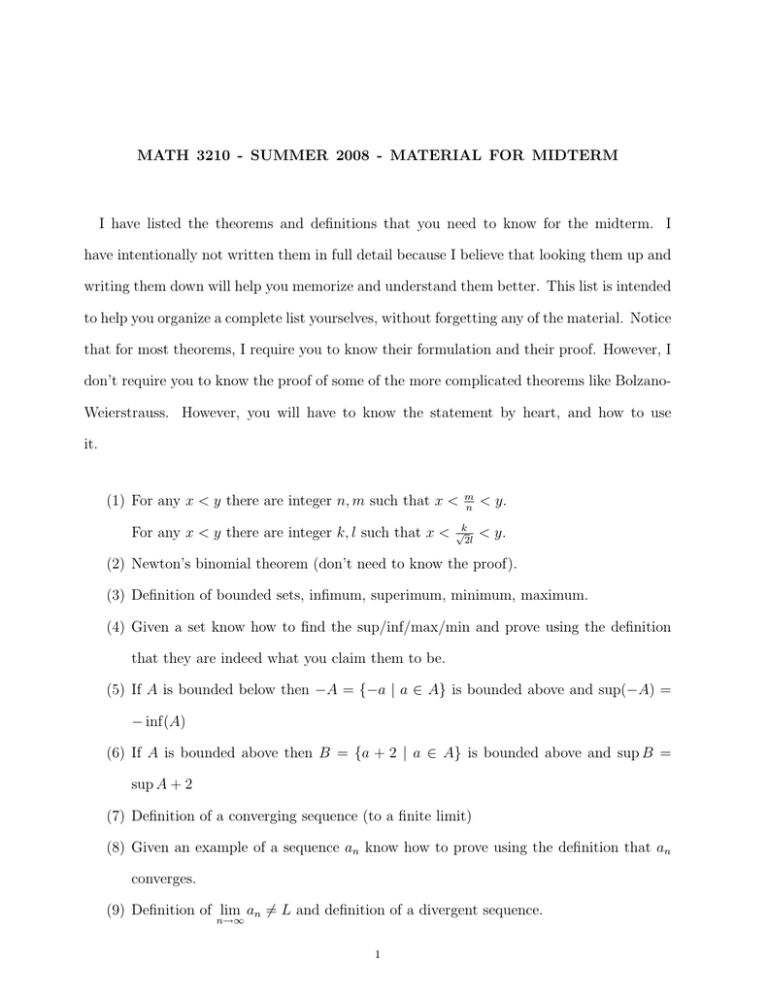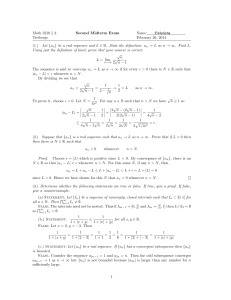MATH 3210 - SUMMER 2008 - MATERIAL FOR MIDTERM
advertisement

MATH 3210 - SUMMER 2008 - MATERIAL FOR MIDTERM
I have listed the theorems and definitions that you need to know for the midterm. I
have intentionally not written them in full detail because I believe that looking them up and
writing them down will help you memorize and understand them better. This list is intended
to help you organize a complete list yourselves, without forgetting any of the material. Notice
that for most theorems, I require you to know their formulation and their proof. However, I
don’t require you to know the proof of some of the more complicated theorems like BolzanoWeierstrauss. However, you will have to know the statement by heart, and how to use
it.
m
n
< y.
√k
2l
< y.
(1) For any x < y there are integer n, m such that x <
For any x < y there are integer k, l such that x <
(2) Newton’s binomial theorem (don’t need to know the proof).
(3) Definition of bounded sets, infimum, superimum, minimum, maximum.
(4) Given a set know how to find the sup/inf/max/min and prove using the definition
that they are indeed what you claim them to be.
(5) If A is bounded below then −A = {−a | a ∈ A} is bounded above and sup(−A) =
− inf(A)
(6) If A is bounded above then B = {a + 2 | a ∈ A} is bounded above and sup B =
sup A + 2
(7) Definition of a converging sequence (to a finite limit)
(8) Given an example of a sequence an know how to prove using the definition that an
converges.
(9) Definition of lim an 6= L and definition of a divergent sequence.
n→∞
1
(10) Given a sequence which doesn’t converge to L, know how to prove this using the
definition.
(11) Given a divergent sequence know how to show that it doesn’t converge to any limit.
(12) Know how to prove that if an converges then it is bounded.
(13) Know the formulation of the main limit theorem. Know how to prove that can → ca,
an + bn → a + b.
(14) Know how to prove that if an → 0 and bn is bounded then an bn → 0
(15) If an → a > 0 then there is an N s.t. ∀n > N : an > 0. know it and consequences.
(16) Know the proof and formulation of the sandwich theorem.
(17) Definition of a monotonic sequence.
(18) formulation and proof of the monotone convergence theorem.
(19) Given a sequence that is defined inductively, know how to find its limit and prove
that it converges (usually need induction).
(20) formulation of the inequality of the means
(21) (1 + n1 )n converges (don’t need to memorize proof).
(22) Definition of a subsequence.
(23) Know the formulation: every sequence has a monotonic subsequence.
(24) Definition of partial limits, given a sequence know how to find all the partial limits.
(25) know formulation and proof: if an → a then ank → a for every subsequence.
(26) know the formulation of the Bolzano-Weierstrauss theorem.
(27) know the formulation of the nested intervals theorem.
(28) definition of infinite limits.
2





